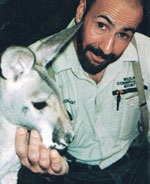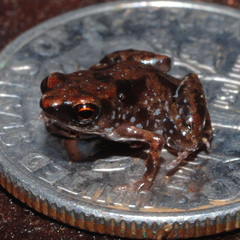 In the course of my work with captive amphibians and reptiles I have often noted that the activity patterns of some seemed strictly controlled from within, while others were quite flexible. This varied from species to species, and sometimes among individuals within the same species.
In the course of my work with captive amphibians and reptiles I have often noted that the activity patterns of some seemed strictly controlled from within, while others were quite flexible. This varied from species to species, and sometimes among individuals within the same species.
We know that most if not all species, ourselves included, are influenced by what might be described as an “internal clock”. A number of processes, including daily activity patterns (termed circadian rhythms) are affected. My own observations involved both daily and seasonal activities of a number of species.
 At one point I was caring for exhibits housing white-lipped treefrogs, Litoria infrafrenata and Wallace’s treefrogs, Rhacophorus nigropalmatus at the Bronx Zoo. Both species are largely nocturnal. On nights when zoo-sponsored special events resulted in the exhibit lights being kept on later than usual, each reacted differently. The white-lipped treefrogs became active at 6 PM, the time when the lights would have been turned off on most days (as did, incidentally, the hoards of mice that occupied the building!). The Wallace’s treefrogs, however, did not begin their evening activities until the lights were actually turned off, some 3-4 hours later than usual.
At one point I was caring for exhibits housing white-lipped treefrogs, Litoria infrafrenata and Wallace’s treefrogs, Rhacophorus nigropalmatus at the Bronx Zoo. Both species are largely nocturnal. On nights when zoo-sponsored special events resulted in the exhibit lights being kept on later than usual, each reacted differently. The white-lipped treefrogs became active at 6 PM, the time when the lights would have been turned off on most days (as did, incidentally, the hoards of mice that occupied the building!). The Wallace’s treefrogs, however, did not begin their evening activities until the lights were actually turned off, some 3-4 hours later than usual.
Similar examples abound – wild caught temperate species, such as Eastern painted turtles (Chrysemys picta) usually refuse to eat during the winter months, despite being kept warm. However, the captive born offspring of such a turtle will generally feed throughout the year.
Wild-caught reptiles and amphibians hailing from temperate climates, such as the wood frog, fire salamander and snapping turtle viewed here, may become lethargic and go off feed in winter even if kept at their usually preferred temperatures.
Indian gharials (Gavialis gangeticus) under my care at the Bronx Zoo, hatched in their native northern India, refused to feed during their homeland’s cold season, despite having been shipped to NYC at less than 1 year of age. The habit persisted for the 15 years or so that I was in contact with them. Interestingly, they lost barely any weight during their 3 month long fast, even thought they were kept warm and remained active.
The abstract of an interesting article on temperature cycles in green iguanas is posted at:
http://jbr.sagepub.com/cgi/content/abstract/10/3/248
 That Reptile Blog – Reptile, Amphibian and Exotic Pet Care and Information
That Reptile Blog – Reptile, Amphibian and Exotic Pet Care and Information


